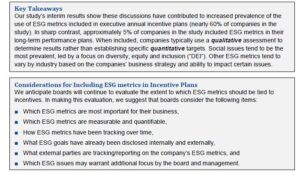 Donald Kalfen
Donald Kalfen
Meridian Compensation Partners, LLC is conducting a study of a group of S&P 500 companies’ disclosures related to the use of environmental, social and governance metrics in their short-term and long-term incentive programs. The study’s initial findings are discussed below, and will be periodically updated to reflect our review of additional proxy statements.
Background
In recent years, companies have become increasingly focused on addressing environmental, social and governance (ESG) issues. Shareholders, proxy advisors and employees have called for companies to incorporate ESG issues into their business strategy. Until recently, it was unclear how quickly, and to what degree, this increased focus on ESG issues would be reflected in executive compensation plans.
Companies often pointed to annual sustainability or corporate social responsibility reports and increased disclosure on ESG accomplishments and commitments to address investor and other stakeholder questions and concerns. Historically, most companies stopped short of including ESG measures in incentive compensation plans for senior executive officers. However, growing interest in ESG issues among major investors has sparked boardroom discussions on whether ESG metrics should be included in incentive plans.

Scope of Meridian Study
The discussion below provides high-level insights into the use of ESG metrics in annual incentive and long-term performance plans among 266 S&P 500 companies (study companies) that filed proxy statements on or after October 1, 2020 through April 28, 2021. We will be publishing updated results covering additional proxy statements filed by S&P 500 companies later in 2021.
Prevalence of ESG Metrics in Annual Incentive and Long-Term Performance Plans
The use of ESG metrics in annual incentive plans has steadily increased over the past few years. According to our study results to date, a majority of companies currently include ESG metrics in their annual incentive plans. We expect this trend to continue in future years, with prevalence likely to increase over time.
Unlike annual incentive plans, we found that ESG metrics are rarely included in long-term incentive (LTI) plans. Companies may be reluctant to include ESG metrics in long-term incentive plans due to the challenge of setting multi-year ESG goals, especially during turbulent economic times. In addition, LTI performance goals are almost always quantitative, where qualitative goals are more accepted in annual plans. Therefore, companies may consider their annual incentive plan to be the most appropriate place to measure performance against specified ESG objectives. Whatever the reason, we do not anticipate a significant uptick of companies including ESG metrics in long-term performance plans, at least in the near-term.

ESG Metrics in Annual Incentive Plans
This section covers the use of ESG metrics in annual incentive plans.
Prevalence of Environmental, Social and Governance Metrics (n-153)
The most common ESG metrics used in annual incentive plans were social metrics, followed by environmental and governance-related metrics.
The high prevalence of social metrics, both in absolute and relative terms, is not surprising. Social metrics cover a wide array of highly visible items, such as diversity, safety and human capital management that have universal application to public companies. In contrast, environmental-related metrics tend to be most prevalent in a limited number of industries (e.g., energy, utilities, materials, real estate and capital goods).
However, we expect most public companies will evaluate how their operations affect the environment (e.g., use of paper, consumption of materials or finished goods with high carbon footprints). Over time, this may increase the prevalence of environmental-related metrics in annual incentive plans across a more diverse array of industries. This trend may also be accelerated by major institutional shareholders (e.g., Black Rock, State Street and Vanguard) which are exerting significant pressure on public company boards to address environmental issues.
We do not anticipate the prevalence of governance-related metrics to substantially increase over time. These metrics tend to cover items already adequately addressed by most companies.

Prevalence of Social Metrics (n-146)
Of those companies including a social metric in their annual incentive plan, over 60% included DEI metrics. DEI metrics are often focused on improving racial, ethnic and/or gender representation. However, to date, most companies’ DEI metrics have not included quantitative goals. Other types of DEI measures being discussed across boardrooms include supplier diversity, diverse board candidate slates and DEI training.
Other social metrics include workforce health and safety and product safety and quality. Historically, these metrics have been among the most prevalent social metrics in select industries’ (e.g., utilities, energy) annual incentive plans.
Relatively new social metrics in annual incentive plans are performance measures related to human capital. We expect the prevalence of these metrics to increase over time due to significant shareholder and stakeholder interest and the recent SEC requirement that public companies’ annual 10-K filings include disclosure on human capital management, as well as pressure around public disclosure of EEO-1 data.

Prevalence of Environmental Metrics (n-59)
Nearly 60% of companies that included at least one environmental metric in their annual incentive plan were in one of the following industries: energy, utilities, materials, capital goods and real estate.
Of those companies that included an environmental metric in their annual incentive plans, 54% included carbon and climate metrics. These metrics included greenhouse gas emissions, carbon footprint, emissions containment and deployment of renewable energy.

Prevalence of Governance Metrics (n-17)
Companies appear to be relatively disinterested in including governance metrics in their annual incentive plans. Of the 153 companies that included at least one ESG metric in their annual incentive plan, only 17 companies (or 11%) included at least one governance metric. Listed below are the most prevalent governance metrics included in annual incentive plans:
■ Cybersecurity and data privacy metrics – 9 companies
■ Business ethics – 7 companies
■ Board diversity – 4 companies
Companies may be reluctant to include the first two metrics in their annual incentive plans for a variety of reasons, including: (i) perceived difficulty in measurement, (ii) belief that incenting top executives to meet cyber security and business ethics goals is inappropriate and (iii) concerns regarding optics on disclosing whether cyber security and business ethics goals have been met.
The low prevalence of board diversity metric in an annual incentive plans is not surprising given that a company’s executive team generally has limited control or influence over who is nominated for and elected
to a board seat.
Form of ESG Metrics (n-153)
Approximately one-third of companies disclosed an assigned weight for an ESG metric used to determine annual incentive payouts.
Two-thirds of companies did not disclose any assigned weight for ESG metrics included in their annual incentive plans. Often, these ESG metrics were part of a list of other unweighted individual performance objectives (with the total individual performance objectives generally weighted between 10% and 25%).
A small but growing minority of companies used ESG metrics as a performance modifier.
Few companies disclosed specific quantitative goals for ESG metrics. However, over time, pressure may build for companies to hold executives accountable for achieving specific ESG goals.

Weighting of ESG Metrics (n-52)
As noted above, approximately one-third of companies disclosed an assigned weight for an ESG metric in an annual incentive plan. No single percentage weight stands out; however, the most prevalent weightings were 10% and 20%.
Over time, the weighting of ESG metrics may increase due to continued shareholder and stakeholder pressure to link a meaningful portion of executive annual incentives to the ESG metrics. However, we expect the majority of annual incentive goals to remain focused on traditional profitability and growth goals.

ESG Metrics in Long-Term Performance Plans
For a variety of reasons, companies have been reluctant to include ESG metrics in their long-term performance plans. Of the 266 S&P 500 companies covered by our study, only 5% (i.e., 13 companies) included at least one ESG metric in their long-term performance plans. The most common ESG metrics used were social metrics (9 companies), followed by environmental (6 companies) and governance-related metrics (1 company). Listed below are the most prevalent types of ESG metrics included in long-term performance plans.
■ Carbon and Climate – 6 companies
■ Health & Safety – 5 companies
■ Human Capital – 4 companies
We do not anticipate a significant uptick of companies including ESG metrics in long-term performance plans, at least in the near-term.
* * * * *
The Client Update is prepared by Meridian Compensation Partners’ Governance and Regulatory Team led by Donald Kalfen. Questions regarding this Client Update or executive compensation technical issues may be directed to Donald Kalfen at 847-235- 3605 or dkalfen@meridiancp.com.
This report is a publication of Meridian Compensation Partners, LLC, provides general information for reference purposes only, and should not be construed as legal or accounting advice or a legal or accounting opinion on any specific fact or circumstances. The information provided herein should be reviewed with appropriate advisors concerning your own situation and issues.
www.meridiancp.com
